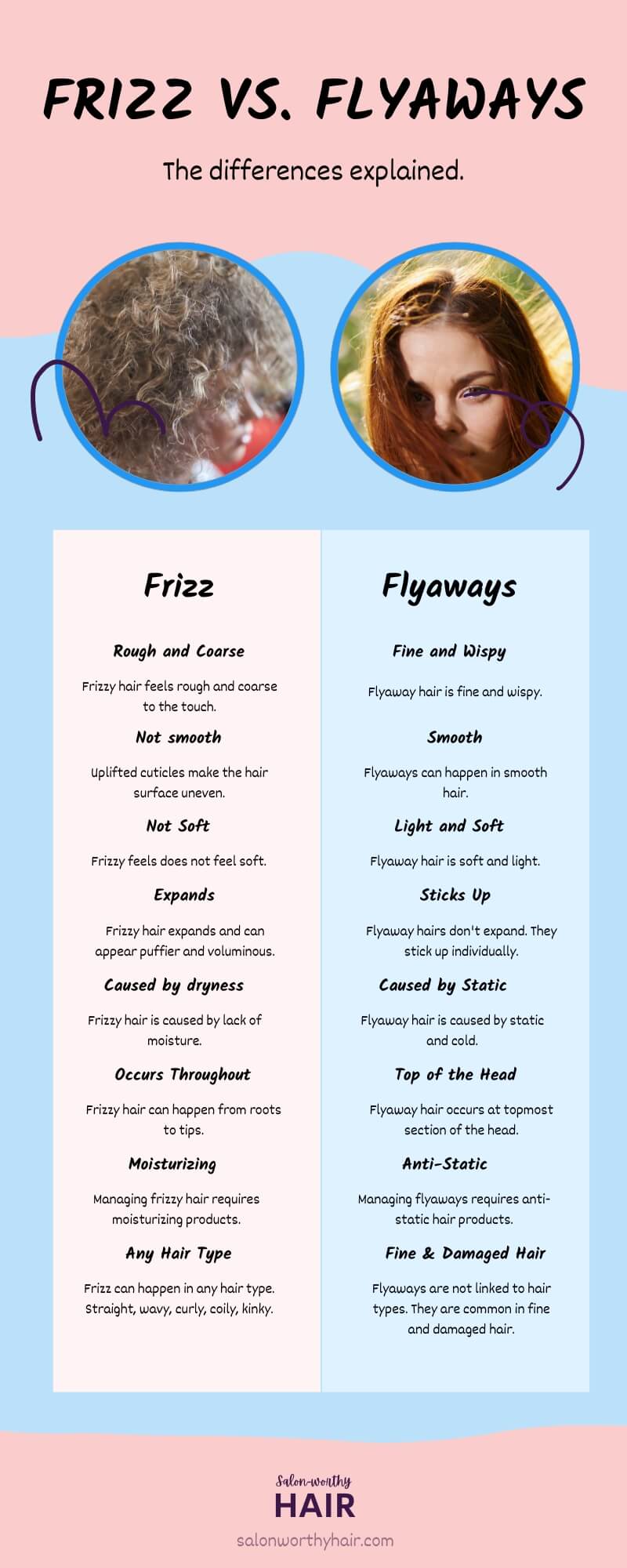Frizz or Flyaway Hair: What are the Differences?
Updated on
This post may contain affiliate links. As an Amazon Associate, we may earn from qualifying purchases.

Frizz and flyaway hair are two hair concerns that can leave many people scratching their heads.
While frizz and flyaways may look similar, they stem from different causes and require targeted solutions.
The main difference between frizz and flyaways are:
Frizz is hair with a puffy, untamed texture. It’s like hair’s response to humidity or damage – the hair cuticles lift, allowing strands to absorb moisture and swell. The result? A messy, unmanageable mane.
Flyaways are fine, wispy rebel strands that separate from the main hair mass, seemingly defying gravity. Their uprising is often due to static electricity, moisture deficiency, or underlying hair damage.
Understanding the nuances between frizz and flyaways can help you tailor your haircare solutions accordingly.
Let’s explore the comprehensive list of distinctions, underlying causes, and tell-tale signs of frizz and flyaways.
The illustration below shows the comparison between frizz and flyaway hair:

Differences between frizz and flyaways:
- Frizzy and flyaway hair have different textures.
- Flyaway hairs can be smooth. Frizz hair is not smooth.
- Flyaway hair is light and soft. Frizzy hair is not soft.
- Frizzy hair expands. Flyaway hairs blow and stick up.
- Frizz is caused by lack of moisture. Flyaway hair is caused by static, damage, or new growths.
- Frizz occurs throughout the hair. Flyaways occur at the top and around the hairline.
- Managing frizz requires moisturizing products. Flyaways require anti-static products.
- Frizz can affect any hair type. Flyaway hair affects fine or damaged hair.
Frizz and Flyaways Are Two Different Hair Textures
Frizz and flyaways have distinct differences in texture and feel. Frizzy hair appears bushy and feels coarse, often resulting from dryness and a lack of smoothness. Frizz makes the hair appear unruly, with an uneven texture that lacks the uniformity of well-moisturized hair. In contrast, flyaway hair is characterized by fine, wispy strands that detach from the main hair mass. These delicate and feather-like strands are light and delicate, imparting a soft feel. While frizzy hair’s dense and rugged appearance is hard to miss, the sparsity and finesse of flyaways lend an almost ethereal appearance.
While flyaways can be seen even on smooth hair, often resulting from static electricity, new growth, or breakage, frizz typically stems from a deficiency in moisture and smoothness.
Flyaway Hair Can Be Smooth. Frizzy Hair Is Not Smooth
Flyaway hair can be caused by static electricity, causing individual hair strands to repel one another. However, flyaways do not compromise the hair’s smoothness or overall health. One can experience flyaways even with conditioned, smooth hair, particularly in dry or cold environments where static is prevalent.
Frizzy hair, in stark contrast to flyaways, is inherently devoid of smoothness. Its appearance is dry, dull, and expansive. The hair strands in this state have uplifted cuticles, meaning the protective outer layer of the hair strand isn’t lying flush against the shaft. This non-uniform alignment of cuticles disrupts the hair’s natural smooth surface, causing the texture to appear and feel coarse and rough rather than soft and supple.
Flyaway Hair Is Light and Soft. Frizzy Hair Is Not Soft
Flyaway hair epitomizes softness in its character. It is light to the touch, often presenting as delicate, ethereal wisps that break free from the main body of hair. Each strand feels silky, portraying an essence of airy gentleness.
Frizzy hair is devoid of the softness inherent in flyaway hair. Instead, the texture of frizzy hair veers towards coarseness, with strands feeling rough and gritty. This abrasive texture emerges from expanded hair shafts, often a consequence of raised or damaged cuticles that don’t align evenly on the surface of the hair shaft.
While flyaway hairs manifest as singular, soft strands poking out, frizzy hair presents as a thick, expanded mass of unmanageable hair.
Frizzy Hair Expands, While Flyaway Hairs Rebel and Stick Up
Frizzy hair is synonymous with expansion. It swells under the influence of high humidity, consuming excess moisture that makes it appear puffier and much more voluminous. This expansive behavior doesn’t just stop at the visual aspect; on a microscopic level, the swelling prompts the hair’s cuticle cells to elevate, exacerbating the frizzy appearance.
Flyaway hairs, on the other hand, don’t just expand; they audaciously stick up, rebelling against the collective mass of hair. These defiant strands detach, standing out prominently. The lightness of flyaway hairs, coupled with factors like static electricity, makes them prone to sticking up and getting blown away, lending hair a wispy and errant appearance. The sticking-up phenomenon isn’t arbitrary. Causes range from static electricity, which makes hair strands repel each other, to damage from aggressive styling. Moreover, newly sprouted hairs, still not anchored by weight or alignment, also contribute to flyaways.
Frizz Is Caused by Lack of Moisture. Flyaway Hair Is Caused by Static, Damage, or New Growths
Although “frizz” and “flyaway” might be used interchangeably, they stem from different sources. Frizz is a direct consequence of hair that’s dehydrated and deficient in moisture. Such hair seeks to absorb moisture from its environment, causing strands to swell and produce a frizzy texture.
Conversely, flyaways are the offspring of multiple factors. They can arise from static electricity, making the hair stand on end. Damaged hair, whether due to aggressive styling tools or chemical treatments, becomes brittle and more likely to break, leading to stray, stand-out strands. Additionally, new hair growths, with their shorter length, may not seamlessly blend with longer strands, presenting as flyaways.
Frizz Occurs Throughout the Hair, While Flyaways Occur at the Top of the Head and Around the Hairline.
Frizz can surface anywhere from the roots at the base of your scalp to the tips of your strands. This ubiquitous presence gives hair an overall messy and textured appearance, making it seem unruly no matter which section you observe.
In contrast, flyaways are predominantly seen adorning the head’s crown or topmost section and noticeably accentuate areas around the hairline, encompassing the forehead and temples.
Unlike the all-over chaos of frizz, flyaways tend to be localized, offering a distinct halo-like appearance in these areas. As a result, it’s easier to manage flyaways with touch-up anti-static hair products.
Frizz Can Be Managed with Moisturizing Products. Flyaways Require Anti-Static Products
Frizzy hair results primarily from a lack of moisture, making moisturizing products essential for its management. Such products restore the hair’s hydration equilibrium. This category of hair products includes conditioners, shampoos, hair masks, and leave-in treatments enriched with moisture-boosting ingredients like avocado, banana, coconut milk, argan oil, and shea butter.
On the other hand, flyaways are often a result of static electricity. Anti-static hair products are specifically formulated to tackle this issue. They function by neutralizing the electrical charges on the hair. Key ingredients in these products, such as silicones and natural oils, coat each hair strand with a protective layer.
Anti-static hair products reduce friction between hairs and other surfaces, preventing pesky flyaways.
Frizz Can Affect Any Hair Type. Flyaway Hair Affects Fine or Damaged Hair
Every hair type, be it thick, coarse, curly, or wavy, can fall prey to frizz. The natural structure of these hair types makes them more susceptible to dryness, which is a primary factor behind frizziness. Their innate characteristics often mean a rougher cuticle, making them more vulnerable to moisture loss and frizz.
Conversely, flyaways are unrelated to hair’s natural type or texture. Instead, flyaways are more common in fine and damaged hair. The delicate nature of fine hair strands and their lighter weight make them susceptible to floating and separating, leading to flyaways. Damaged hair, having compromised cuticles, breaks more easily and lends itself to flyaways.
It’s important to note that frizz and flyaways are not mutually exclusive. An individual with naturally curly hair might experience frizz due to raised cuticles and simultaneously face flyaways from the inherent fine quality of their curls. Similarly, damaged hair can be plagued by the unruly roughness of frizz and the delicate detachment of flyaways.
How to Fix Flyaways and Frizz
Managing frizz and flyaways hinges on the right care routine and judicious use of styling products and tools.
How to Tame Frizzy Hair:
- Always keep your hair well-moisturized.
- Invest in dedicated frizz control products that seal in moisture, like an anti-frizz serum
- Limit the use of hot styling tools, or use heat protection every time you use hot tools.
- Style your hair when it’s damp, not when it’s dry.
How to Get Rid of Flyaway Hair
To get rid of flyaway hairs, you can try the following methods:
- Use flyaway tamers like anti-static dryer sheets designed to smooth and control flyaways.
- Avoid aggressive brushing – it causes statics in the hair.
- Try a flyaway stick for hair, which can provide targeted control and help tame unruly hairs.
- Apply a small amount of hair gel to gently pat down flyaways and keep them in place.
- Use a flyaway cream that is formulated to smooth and tame stray hairs.
- Consider using a pomade, which can give flyaways a strong hold and control.
Frizz or Flyaway Hair?
Frizz and flyaways, while often used interchangeably, have distinct characteristics.
Frizz is hair that feels dry, rough, and unmanageable. It often looks bushy or coarse, predominantly due to humidity, hair damage, or insufficient care. The entire hair mass tends to lose its smoothness, giving it an unruly appearance.
Flyaways are fine, wispy strands that detach from the main hair body, commonly noticeable around the crown or hairline. They’re the little rebels that break away from your chosen hairstyle, lending a slightly untamed, sometimes playful, look to the overall appearance.
You can tackle each hair concern by understanding these nuances using the right techniques and products.
About the Author
 Tina Moretti
Tina MorettiTina Moretti, a passionate hair care enthusiast with over a decade of expertise, dedicates herself to empowering women with proven hair care advice. Recognized for her hands-on experience and trusted guidance, Tina turns every strand into a statement of beauty and confidence.